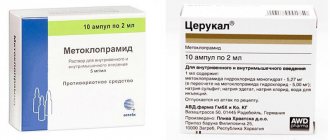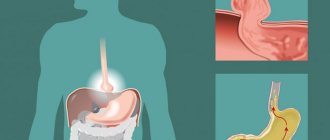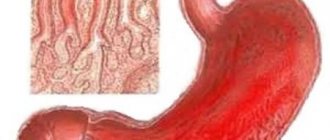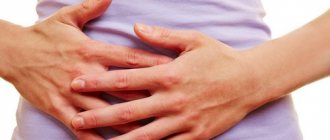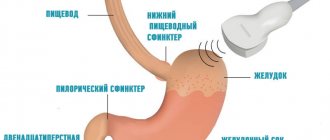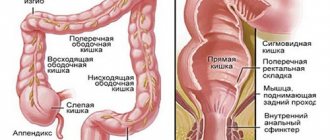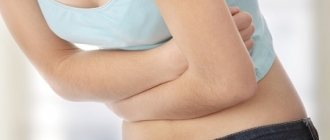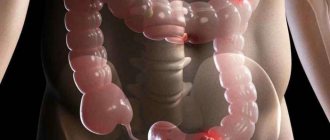What is erosive duodenitis and how to distinguish it from other diseases
Erosive duodenitis is an inflammatory disease of the duodenum, which has an acute and chronic course. With this pathology, erosions and ulcers form on the intestinal mucosa. Symptoms and treatment of the pathology will depend on the nature of the disease.
Causes
There can be a variety of reasons for the development of this pathology.
Helicobacter pylori
The main causes of erosive duodenitis:
- alcohol and nicotine abuse;
- Helicobacter pylori infection;
- chemical poisoning;
- treatment of other diseases of the body with antibiotics and painkillers;
- food poisoning;
- unhealthy diet (energy drinks, coffee, spicy and exotic foods);
- stress, a sign of which is lack of adequate sleep;
- antral gastritis.
Kinds
Inflammatory bowel diseases are classified depending on the nature of the pathology, the localization of erosions in the duodenum, and the endoscopic picture upon examination.
According to the nature of the course, they are distinguished: acute and chronic duodenitis.
Acute erosive duodenitis occurs with pronounced complaints, has a sudden onset and rapid development of symptoms.
Chronic erosive duodenitis can be masked by its manifestations as other diseases of the digestive tract.
Based on the location of the inflammatory focus, they are distinguished:
- proximal (when the duodenal bulb is involved) – bulbitis;
- distal – there are no changes in the bulb.
According to the endoscopic picture during FGDS:
- erosive-ulcerative;
- erosive-hemorrhagic (erosions covered with blood).
Often the symptoms of the inflammatory process in the intestines are accompanied by duodenogastric reflux and resemble reflux gastritis or reflux esophagitis, but the treatment of these diseases will be different.
What is erosive duodenitis
Erosive duodenopathy is inflammation of the lining membranes of the stomach and duodenum with the appearance of ulcerative-erosive foci . This is a common disease in gastroenterology and occurs at a young age, regardless of gender.
Typical symptoms are epigastric pain, especially after eating, bleeding, and stool disturbances . The trigger for the development of erosive duodenitis in most cases is considered to be Helicobacter pylori infection.
Therapy for ulcerative-erosive gastroduodenitis is aimed at eliminating symptoms , protecting the membranes, and treating infection caused by Helicobacter pylori. ICD-10 code - K29.4 - erosive gastroduodenitis.
Forms and types
The disease is classified into the following forms:
- acute duodenitis - vivid symptomatic manifestations, rapid onset, timely treatment quickly prevents the development of complications and leads to recovery;
- chronic - lack of treatment or inadequate therapy contributes to the chronicization of the pathological process; it is often disguised as other concomitant diseases of the gastrointestinal tract.
Acute and chronic duodenitis poses a danger to all organs of the gastrointestinal tract , disrupts the processes of digestion and absorption, and causes secretory-evacuation-motor disorders.
The following types of erosive duodenitis are distinguished :
- superficial - inflammation covers only the upper shells of the lining epithelium;
- atrophic - the disease is accompanied by thinning of the mucous membranes and impaired secretion;
- interstitial - glandular atrophy of the membranes of the duodenum is observed;
- hyperplastic - characterized by the proliferation of the lining epithelium of the duodenum.
According to the localization and depth of damage to the duodenal membranes, there are proximal (involvement in the inflammation of the duodenal bulb) and distal (the bulb is not involved in inflammation) types of the disease.
What happens in the body
The basis of the morphological changes in the mucous membranes is the formation of crater-shaped ulcerative elements that do not affect the muscular and deep submucosal layers. The secretion of the duodenum is significantly impaired, due to bleeding, the level of hemoglobin decreases, and with the progression of erosive duodenitis, the risk of deeper damage to the lining membranes and severe complications increases.
Important! The danger of erosive duodenitis lies in the creation of a favorable background for the formation of a malignant tumor. Most patients with confirmed cancer of the stomach and duodenum were previously diagnosed with a chronic erosive-inflammatory process.
Symptoms of acute erosive duodenitis
Duodenitis is accompanied by complaints that are characteristic of other diseases of the gastrointestinal tract.
The onset of the disease may be asymptomatic. As the process develops, symptoms of acute erosive duodenitis appear:
- nausea, sometimes vomiting;
- loss of appetite for no apparent reason;
- unstable stool - constipation is replaced by diarrhea;
- pain in the upper abdomen becomes severe and prolonged, cramping and “hungry” pain appears, relieved by eating;
- feeling of early satiety (fullness of the stomach already at the beginning of a meal).
Endoscopic signs
An endoscopic picture of intestinal inflammation makes it possible to immediately determine the patient’s treatment tactics. The main signs of erosive duodenitis will be small wounds and ulcers of various shapes, single or in groups on the duodenal mucosa. The inner lining of the intestines becomes inflamed throughout, and the gastric mucosa is often involved in the process.
Symptoms of erosive gastroduodenitis
Aching pain in the upper abdomen that occurs immediately after eating. Sometimes the pain radiates to the shoulder or back. Quite often – constant, small.
A feeling of fullness and heaviness in the abdomen, regardless of the amount of food eaten.
Nausea, belching and heartburn, especially with reflux esophagitis.
Appetite is often unchanged.
Unpleasant taste in the mouth and bad breath in the morning.
In case of exacerbation - nausea and vomiting. The vomit contains mucus and dark clots of blood neutralized with hydrochloric acid.
Bloating.
Stool disorder - alternating diarrhea and constipation.
Darkening of the stool - the color of tar (with erosive-hemorrhagic gastroduodenitis).
Astheno-neurotic syndrome: decreased mood and performance, weakness, sleep disturbance, cardialgia (imitation of heart pain).
With significant bleeding (erosive-hemorrhagic gastroduodenitis) - signs of anemia: pallor of the skin and mucous membranes, tachycardia, decreased blood pressure, weakness, increased fatigue, decreased blood hemoglobin levels.
Diagnostics
Before prescribing treatment for erosive gastroduodenitis, diagnosis is carried out using a number of examinations:
- Careful questioning of the patient and taking anamnesis.
- General blood and urine analysis.
- Biochemistry of blood.
- Urine for the amount of pepsinogen.
- Feces for occult blood.
- EGDS with biopsy.
- Determination of the presence of Helicobacter in the body: stool test for antibodies to Helicobacter, breath test for urease activity, identification of bacteria in biopsy material, test of blood serum for antibodies.
- Ultrasound of the abdominal organs.
Chronic gastroduodenitis can last a long time, periodically exacerbating. Unlike peptic ulcers, this disease is not characterized by seasonal exacerbations.
Symptoms of chronic erosive duodenitis
Manifestations of chronic erosive duodenitis are characterized by a less aggressive course. In this situation, there will be no sharp decrease in appetite, the pain lasts less long and all the symptoms disturb the patient from time to time. Erosive duodenitis is often a complication of gastritis, pancreatitis, and catarrhal gastroduodenitis. Therefore, it is important to analyze all the symptoms and not ignore them, since prolonging the situation can lead to unwanted complications.
Signs
Endoscopic signs of an inflammatory bowel condition during examination help to distinguish an acute process from a chronic one.
Endoscopic photo
The endoscopic picture of chronic erosive duodenitis, as a rule, confirms the clinical manifestations of the disease. When conducting a study, the doctor sees multiple or single erosions with protruding edges - this is a sign of a chronic process and a long course.
In an acute process, erosions can be covered with blood or a fibrinous film, which indicates regeneration, that is, healing of some erosions. The diagnosis must also be confirmed by a morphological examination of the mucous membrane of the duodenum. This involves performing a biopsy - pinching off the intestinal mucosa for examination under a microscope. Chronic inflammation of the intestine of any location is fraught with the degeneration of healthy tissue in the lesion into an oncological process.
Causes of chronic duodenitis
Chronic duodenitis - causes, symptoms, treatment, dietary table
Primary chronic duodenitis most often occurs due to regular errors in nutrition and abuse of irritating foods. Smoking is considered one of the provoking factors: nicotine constricts blood vessels, including the vessels of the mucous membrane of the gastrointestinal tract, and against the background of insufficient blood supply, its protective and restorative abilities are reduced.
Secondary duodenitis in 95% of cases develops against the background of a duodenal ulcer, but other diseases can also provoke it:
- chronic gastritis caused by Helicobacter;
- parasitic invasions of the biliary tract (giardiasis, opisthorchiasis);
- chronic pancreatitis;
- chronic liver diseases;
- uremia;
- severe cardiovascular failure.
In all these conditions, the aggressive effect on the mucous membrane increases in one way or another. Such aggressive factors can be waste products of parasites or Helicobacter, changes in the pH of pancreatic juice during pancreatitis, toxic nitrogenous metabolic products during uremia, and so on.
As a result, the balance between the protective properties of the mucous membrane and damaging effects is disrupted, which causes inflammation. That is why it is quite difficult to completely cure chronic duodenitis: to do this, you need to identify and eliminate the root cause.
Diagnostics
The course of treatment for any disease is prescribed after a full diagnosis.
List of studies for erosive duodenitis:
- physical examination by a doctor, collection of personal family history;
- laboratory and instrumental studies: general blood test;
- feces for occult blood;
- blood chemistry;
- fibrogastroduodenoscopy;
- Ultrasound of the abdominal organs,
- urease test for Helicobacter pylori.
Depending on the examination results, the doctor determines whether the patient has an acute or chronic process.
Fibrogastroduodenoscopy allows you to identify additional diseases: superficial gastritis, reflux gastritis, and also assess the severity of all inflammatory processes in the stomach and duodenum.
FGDS
The presence of concomitant pathologies only aggravates the condition of a sick person, so it is important to identify all problems at the examination stage and correctly prescribe therapy.
Symptoms
Typical symptoms of erosive duodenitis are accompanied by:
- distension in the abdomen;
- pain and discomfort in the epigastrium;
- spastic pain during fasting or poor diet;
- nausea or vomiting after eating;
- constipation, stool disorders;
- blackening of the stool and internal bleeding.
Symptomatic manifestations can vary greatly , their severity and severity depend on the degree and depth of involvement of the tissues of the lining of the stomach and duodenum in the pathological process.
Treatment
Therapy is carried out on an outpatient basis. Erosive duodenitis responds well to conservative treatment.
In the acute stage, diet plays an important role. Drug therapy includes:
- proton pump inhibitors (Omeprazole);
- antispasmodics (“Duspatalin”);
- antacid drugs (“De-nol”, “Gastronorm”, “Phosphalugel”);
- sedatives;
- If a Helicobacter pylori infection is detected, antibiotics (amoxicillin, clarithromycin) must be prescribed.
The treatment plan is written for two weeks.
If the patient’s condition improves, then a repeat visit to the gastroenterologist should occur in 7 to 10 days.
Remember!
The success of treatment depends primarily on nutrition, the neuro-emotional state of the patient, and not on pills. No matter how good the drug is, it is only an addition to the main requirement of therapy - diet.
Erosive-hemorrhagic and erosive-ulcerative duodenitis can lead to complications requiring surgical treatment. The gastroenterologist and endoscopist always work in tandem. If the endoscopist additionally sees a picture of gastritis or reflux esophagitis during the examination, then the treatment plan must be adjusted by the gastoenterologist taking into account these data.
Treatment of chronic duodenitis
During an exacerbation of chronic duodenitis, it is necessary to adhere to a diet and take medications in a timely manner to avoid painful night pain
Since in most cases chronic duodenitis is of a secondary nature, treatment begins with treatment of the underlying disease. During the period of exacerbation, diet table No. 1 is recommended, for milk intolerance - No. 4. Gradually, other foods are included in the diet, transferring the patient to table No. 15.
If tests for Helicobacter pylori are positive, a complex of drugs to destroy it is prescribed, consisting of a proton pump inhibitor and two types of antibiotics.
If chronic duodenitis manifests itself as an ulcer-like variant, treatment is aimed at reducing the secretory activity of the gastrointestinal tract: proton pump inhibitors (omeprazole, pantoprazole, lansoprazole, rabeprazole, esomeprazole) and H2-histamine receptor blockers (ranitidine, famotidine) are recommended. Moreover, it is very important to take these medications in the evening to prevent night pain.
To restore motor function, prokinetics (domperidone, metoclopramide, trimebutine) are recommended.
To reduce the activity of inflammation and restore the normal structure of the mucous membrane, gastroprotectors (rebamipide) are recommended. Rebamipide restores protective functions, activates cell restoration, improves microcirculation, and accelerates the healing of the gastrointestinal mucosa.
Diet
Nutrition for this disease is based on the intake of mechanically and thermally gentle food.
In the acute period, table No. 1 is used for the first 2 to 3 days. All food should be boiled, but not pureed. Dishes are prepared with limited salt, without frying. Meals should be 5-6 times a day, in small portions. In subsequent days, the diet is expanded.
Table 1. Allowed and prohibited dishes and products
| Can | It is forbidden |
| Light soups with vegetable broth; Well-cooked porridge; Mashed potatoes; Boiled vegetables; Steamed or boiled fish and chicken, baked in the oven; Steam omelette; Cottage cheese and cheesecakes. | Pasta; Fresh bread; Sour juices; Coffee, kvass, soda, alcohol; Pickled, spicy and smoked foods. |
Causes
The process of inflammation in the duodenum occurs in response to the action of damaging factors on the intestinal mucosa, which causes an imbalance in the mutual balance of aggression and defense factors. Aggression factors are a complex of factors, including the destructive effects of hydrochloric acid and digestive enzymes, trauma to the mucous membrane and duodenum. Protective factors are the normal state of cell regeneration, blood circulation of the duodenal mucosa.
Primary duodenitis can be considered as an independent disease. They develop after acute duodenitis or as a result of factors that have a damaging effect on the cells of the intestinal mucosa. These factors include:
- flaws in nutrition (predominance of fatty, fried, spicy foods, etc.);
- excessive addiction to alcohol;
- excessive consumption of coffee and tea;
- smoking;
- poisoning;
- traumatic damage to the wall of the duodenum by a foreign body.
Secondary duodenitis is a complication of chronic diseases of the digestive system. With any ailment of the gastrointestinal tract, the duodenum can be involved in the pathological process, since it has a close connection with other digestive organs. These include:
- ulcer of the digestive mucosa;
- chronic gastritis;
- chronic pathologies of the pancreas and biliary tract;
- gastrointestinal diseases associated with Helicobacter pylori infection;
- chronic hepatitis.
Diseases of individual systems and organs can also provoke secondary duodenitis. For example, these are diseases of the lungs, heart and blood vessels, which cause oxygen starvation of cells and tissues, or renal failure, which disrupts the excretory function of the kidneys, and the release of toxic products of nitrogen metabolism passes through the mucous membrane of the duodenum. Heredity also plays an important role in the development of the disease, so duodenitis in children can often cause vegetative dystonia syndrome and allergies.
Folk remedies
Folk remedies are widely used:
- flax seeds;
- decoction of St. John's wort and chamomile;
- infusions of coltsfoot, motherwort, calendula, dill.
In medicine, this treatment is called herbal medicine. They use herbs that have anti-inflammatory, antispasmodic, and analgesic effects. Some herbs have healing effects that are not inferior in strength to pharmaceutical drugs. Herbal infusions are often used to potentiate, that is, enhance each other’s actions. Each collection is intended for a specific situation and can be used for 5 to 6 weeks.
The method of preparing the herbal collection is usually similar. Take 2 - 3 tablespoons of the mixture, pour 500 ml of boiling water and leave for 60 minutes. You need to drink the prepared mixture 30 minutes before meals 3 times a day.
An example of a herbal mixture used for erosive gastritis:
- chamomile flowers;
- calendula color;
- coltsfoot leaves.
Raw materials are mixed in equal proportions
Inexpensive herbs help effectively treat patients with various diagnoses. They act not only on inflammatory processes of the intestines, but also the stomach and esophagus.
You can add the following to time-tested traditional medicine recipes:
- potato juice;
- fresh cabbage juice.
Flax seeds have a good analgesic and enveloping effect (brewed like herbs, you can boil for 3 - 4 minutes).
Attention!
When treating erosive duodenitis with folk remedies, it is necessary to take into account contraindications, as well as the tendency to allergic reactions.
Prognosis and possible complications
The prognosis for erosive duodenitis is favorable, and timely treatment allows you to avoid possible consequences.
Complications of duodenitis can include:
- intestinal bleeding;
- duodenal ulcer,
- periduodenitis;
- intestinal perforation.
Intestinal bleeding is dangerous due to the rapid loss of large amounts of blood and requires immediate hospitalization and the active intervention of doctors.
Peptic ulcer disease is characterized by severe abdominal pain, nausea (sometimes vomiting), and heartburn. Depending on the severity of the process, it is treated conservatively and surgically.
Periduodenitis is an inflammation of the outer lining of the duodenum. It most often manifests itself as pain in the epigastrium, which can intensify with physical activity, sudden rotation of the body, and poor diet.
Intestinal perforation requires immediate surgical intervention to avoid the development of peritonitis.
What is dangerous about erosive duodenitis is its complications. But patients still hope that they will bypass the prospect of hospital treatment.
Remember!
Timely consultation with a doctor makes it possible to completely eliminate the disease and avoid the transition of acute inflammation into a chronic process, and single erosions into peptic ulcers.
Causes of the disease
This type of duodenitis can be both acute and chronic. Causes of acute erosive duodenitis:
- the patient accidentally drank chemicals, namely acids or other equally dangerous technical liquids;
- the patient’s passion for alcoholic beverages led to the onset of the disease; consumption of stale food;
- a lot of fatty and smoked foods in the patient’s diet, canned food;
- uncontrolled use of certain medications by the patient.
If this is a chronic form of the disease, then it often occurs due to the fact that acute duodenitis was not fully treated, the patient did not want to follow a diet, and the action of the factors provoking the disease did not stop. Many other things also play a role in the development of the disease: the presence of bad habits in the patient, namely smoking, poor diet, constant stress, infection with the bacterium Helicobacter Pylori. Sometimes this pathology develops against the background of other diseases, for example, chronic hepatitis or pancreatitis. Often a patient is simultaneously diagnosed with gastritis and duodenitis, then this disease is called “gastroduodenitis”. The duodenum follows immediately after the stomach. If the synthesis of hydrochloric acid in the stomach is increased, this causes inflammation of its mucous membrane, that is, gastritis, but at the same time, the patient’s duodenum also suffers from the effects of acid, its mucous membrane also becomes inflamed, and without proper treatment, the catarrhal form of the disease will become more severe, erosive .
Prevention
Inflammatory diseases of the stomach and intestines most often develop in children and adolescents. If we consider adults, then – more often in men and older people. The main reason for all gastrointestinal problems is the lack of nutritional culture among the population.
Children and adolescents are the most undisciplined patients. Adults acquire diseases of the gastrointestinal tract not only due to malnutrition, but also due to poor lifestyle, uncontrolled use of pharmaceutical drugs, for example, non-steroidal anti-inflammatory drugs (aspirin, ibuprofen, indomethacin, nimesulide).
Prevention of this pathology consists of timely treatment of all diseases of the digestive tract, eradication of Helicobacter pylori, and regular examination. Timely assistance provides an opportunity to cure the disease and also avoid complications.
Medicines are definitely needed in the acute period - for pain relief, elimination of symptoms of concomitant diseases: GERD, esophagitis, atrophic gastritis. In the chronic course of erosive duodenitis, herbal medicine and diet therapy are often sufficient. At the onset of the disease, a strict diet should always remain first.
Causes of development of erosive gastroduodenitis
External
There are many external causes of erosive gastroduodenitis.
Errors in nutrition: addiction to fatty, spicy, fried and salty foods. Eating foods that are too cold or too hot.
Presence of Helicobacter pylori in the body.
Acute or chronic stress, anxiety-hypnotic syndrome.
Food allergies.
Taking cardiac glycosides, glucocorticoids, non-steroidal anti-inflammatory drugs.
Bad habits: smoking on an empty stomach, alcohol and coffee abuse.
Occupational hazards – inhalation of toxic fumes, poisoning with salts of heavy metals.
